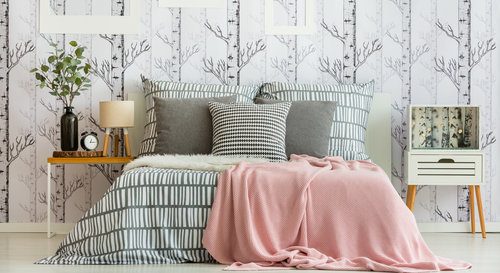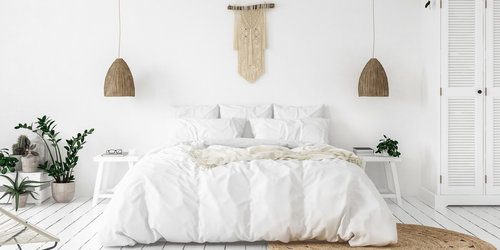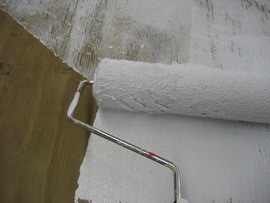Wallpaper vs Paint
Wallpaper
$800 - $1,200
(12x18-foot room, four walls papered, floor to ceiling)
VS
Paint
$320 - $500
(12x18-foot room four walls painted, floor to ceiling)
Cost varies greatly by region (and even by zip code).
To get free estimates from local contractors, please indicate yours.
Wallpaper

- Durable and long-lasting
- Many patterns and styles
- Does not chip
- Does not easily peel
- Expensive
- Affected by humidity
- Not as easy to clean
- Difficult to remove
- Must be professionally hung
- May harm resale of the home
(12x18-foot room, four walls papered, floor to ceiling)
Get free advice and estimates from painters in your city.
Paint

- Many colors and choices
- Can be applied in many patterns
- Unaffected by humidity
- Some types easy to clean
- Easy to change colors
- May be DIY
- Can chip or peel
- Some colors may have a negative impact on resale
- Not as long lasting
(12x18-foot room four walls painted, floor to ceiling)
Get free advice and estimates from painters in your city.
The walls of your home make up a large part of your interior design. Whether you choose to hang photos or artwork on them or leave them bare, the walls set the tone for the look and style of the rest of the space. Part of this has to do with how you treat them. Walls can have a decorative finish in many ways and styles, from a solid paint color to a painted pattern or the addition of wallpaper.
Paint and wallpaper are the two most common methods of treating your walls, but both provide very different looks. We outline the differences between these looks below so that you can make a better decision about which one will work in your home.
Appearance
Both paint and wallpaper are extremely versatile wall coverings. While most people paint their walls a single color, paint can be used to create a variety of effects and patterns. Paint can be rolled or sponged on, splattered, or painted in stripes, dots, chevrons, tiles, or in murals.
Even solid colors of paint have many choices available, including finishes that range from matte to glossy in a wide range of colors. If you make a mistake or tire of a color, it is easy to paint over and change the look of the room.
Wallpaper also comes in an extensive selection of patterns, colors, and finishes. You find flocked, textured, glossy, matte, and metallic wallpaper in a range of solid colors and patterns. Some types of wallpaper are also paintable, allowing you to really customize the look of a room.
The most significant difference is that wallpaper offers less creativity than paint because you can only use what is available, rather than coming up with your own design. Wallpaper can also be more challenging to change or remove if it becomes dirty or you tire of the look.
Best Use
The area where you plan on installing the wallpaper or paint can have an immense impact on the final look and use of the space. Wallpaper in dry areas, such as living rooms or dining rooms, can last for 15 years without maintenance. But in wet areas like kitchens or bathrooms, it may have problems with the humidity, causing the paper to warp or peel. Since wallpaper absorbs moisture from the air, glue can lose its adhesiveness.
Wallpaper is also not usually recommended for children’s bedrooms because it can be difficult to keep clean or change if the child outgrows the pattern. For this reason, paint is usually the recommended finish for areas with high-humidity levels or in areas requiring frequent updates or lots of cleaning.
When installing wallpaper in bathrooms or kitchens, it is common to use tile in areas where the paper may come in direct contact with water or stains to help it last longer.
Installation
Paint is one of the easiest DIY projects for homeowners to perform. A single, solid-color paint job is fairly straightforward. Simply tape off the edges of the room, use a brush to apply the paint to the edges, and then roll in the interior. For patterns or multi-color jobs, a professional may provide better results.
Ideally, a professional who understands the material and process should hang the wallpaper. The rolls of paper need to be cut to size and either dipped in water to activate the glue or brushed with water before being smoothed onto the wall. The different edges need to line up perfectly to avoid interruptions in the pattern, and then the paper must be smoothed with a special tool to remove any air bubbles or excess glue from behind the sheets. This takes considerably more knowledge, skill, and time than painting a wall of the same size, even when painting with different colors or creating a pattern.
Costs
Wallpaper is both more costly to purchase and install than paint for a room of similar size and shape. Wallpaper comes in rolls that cover around 58 square feet at a cost of $30 to $50 a roll. To cover a 12 x 18-foot room, you need 10 rolls for a total of $300 to $500. The cost of labor for a room this size ranges from $500 to $700, making the total expenditure between $800 and $1,200.
To paint the same space, you need about 2 gallons of paint at a cost of around $10 to $50 a gallon or $20 to $100 for the cost of the project. Labor costs are around $50 an hour, with most projects taking 6 to 8 hours to complete, including taping and cleanup for a total cost of $300 to $400 in labor or $320 to $500 for the total project.
Durability
On average, most wallpapers last a minimum of 15 years, and many last even longer when well-maintained. This makes them a great choice for people who do not require much change in their homes and have them installed in low-humidity areas, places with few fingerprints, and without small children.
When scraped in the right way, paint can chip or peel. If this happens, you can touch it up if you have leftover paint. Otherwise, it can be difficult to match, which may necessitate repainting the entire room.
Some paints and wallpapers may be cleaned if they became heavily soiled, such as if children draw on the wall. In most cases, however, paint is easier to keep clean and remove marks from. You can easily remove shoe scuff marks, for example, from most painted surfaces but not from most wallpaper.
Removal
Removing wallpaper can be very difficult, time-consuming, and expensive. In some cases, you can steam it off the wall with the right tool, but in other cases, it may need to be scraped off by hand. In either case, it can take several hours to days to complete an entire room, which is why wallpaper is better for those who do not like much change.
In most cases, paint is generally not removed from the wall because it can be either painted or wallpapered over when you desire a change. Keep in mind that some very dark paint colors may take multiple coats of primer 1 then paint to change to a lighter color. However, if the tone or shade of paint is not a big change, it is easy to alter the color with fresh paint.
Resale Value
Both paint and wallpaper have some impact on the resale of your home. However, of the two, wallpaper may have the biggest negative impact. While a poorly done or brightly colored paint job may deter some people, paint is easily redone or painted over. But because wallpaper does not have as broad an appeal and is difficult and costly to remove, it can hurt the resale of a home.
In most cases, paint has little impact on the sale of a home. A fresh, neutral paint job may enhance sales slightly, however, while a very poorly done or out-of-date color may lower resale slightly. Because paint is more easily changed, most people look past the color when considering a home.
Remodeling Terms Cheat Sheet
Definitions in laymen's terms, cost considerations, pictures and things you need to know.See full cheat sheet.
 1 Primer: Preparatory coat applied to materials (drywall, wood, metal, etc.) before painting to ensure paint adhesion, extend paint durability, and help seal and protect the surface to be painted
1 Primer: Preparatory coat applied to materials (drywall, wood, metal, etc.) before painting to ensure paint adhesion, extend paint durability, and help seal and protect the surface to be painted
How much does it cost in my city?
Cost varies greatly by region (and even by zip code).
To get free estimates from local contractors, please indicate yours.